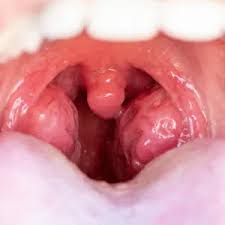How Enlarged Tonsils and Adenoids Affect Children’s Growth, Sleep, and Dental Development — And How Myofunctional Therapy Can Help
- Tracey Coulter
- Jul 14
- 5 min read
Parents often notice signs like snoring, mouth breathing, restless sleep, or crowded teeth in their children but don’t always realize they could be linked to a larger issue: enlarged tonsils and adenoids.
While tonsils and adenoids are often viewed as minor anatomical structures, their chronic enlargement can disrupt airway function, impair sleep quality, delay growth, and negatively impact facial and dental development. In fact, a child’s ability to breathe properly through their nose—something we might take for granted—is a critical factor in healthy physical and cognitive development.
In this article, we’ll explore how enlarged tonsils and adenoids contribute to mouth breathing, how they impact a child’s health and appearance, and how myofunctional therapy can play a key role in addressing these issues—especially when combined with airway-aware dentistry or ENT care.
What Are Tonsils and Adenoids?
Tonsils are two masses of lymphatic tissue located on either side of the throat, and the adenoids are located higher up, behind the nasal cavity. Together, they are part of the immune system and help defend the body against bacteria and viruses.
However, in many children, these tissues can become chronically enlarged (hypertrophied) due to frequent infections, allergies, or inflammation—leading to upper airway obstruction.
Symptoms of Enlarged Tonsils and Adenoids in Children:
Snoring or noisy breathing during sleep
Mouth breathing (day or night)
Difficulty swallowing
Chronic ear infections or sinus congestion
Restless sleep or frequent waking
Enlarged neck glands
Speech changes (nasal voice)
When the tonsils and adenoids block the airway, nasal breathing becomes difficult or impossible, forcing the child to breathe through the mouth—especially during sleep.
The Consequences of Mouth Breathing
1. Altered Facial and Dental Development
Children are meant to breathe through their nose, with the tongue resting on the roof of the mouth (palate). This tongue posture acts as a natural expander for the upper jaw, guiding the growth of the midface.
When a child breathes through the mouth due to blocked airways, the tongue sits low in the mouth. Over time, this leads to:
A narrow upper jaw and high palate
Elongated facial structure (often called “adenoid facies”)
Dental crowding, open bite, or crossbite
Retruded lower jaw (retrognathia)
Asymmetrical facial development
Poor lip seal and weak oral muscles
📚 According to Graber et al., long-term mouth breathing due to nasal obstruction causes “significant skeletal and dental changes,” including vertical maxillary growth and posterior crossbites (Graber TM, 2009).
2. Impaired Sleep and Behavioral Challenges
Children with enlarged tonsils and adenoids often suffer from obstructive sleep apnea (OSA) or sleep-disordered breathing. When airways are partially or completely blocked, the body experiences frequent micro-arousals that disrupt deep sleep stages—essential for healing, memory, and growth.
Poor sleep in children is strongly linked with:


Hyperactivity or ADHD-like behaviors
Learning difficulties and poor concentration
Mood swings and irritability
Nighttime bedwetting
Chronic fatigue
💤 A study published in the New England Journal of Medicine showed that adenotonsillectomy improved sleep and behavior in children with OSA (Marcus et al., 2013).
3. Stunted Physical Growth
Children grow during deep, slow-wave sleep, when human growth hormone (HGH) is released. Repeated sleep disruption due to airway obstruction interferes with this cycle, potentially delaying height and weight gain.
Research shows that children with chronic tonsillar or adenoidal hypertrophy often fall below growth curves. Following adenotonsillectomy (surgical removal), many children experience a “catch-up” growth period.
📈 An article in Pediatrics found that children undergoing adenotonsillectomy had improved growth velocity and increased appetite following surgery (Barbosa et al., 2012).
Myofunctional Therapy: A Non-Invasive Way to Support Long-Term Airway Health
Orofacial Myofunctional Therapy (OMT) is a specialized exercise-based treatment that targets the muscles of the mouth, tongue, face, and throat to promote proper function, posture, and breathing patterns.

What Can Myofunctional Therapy Do?
Retrains proper tongue posture (resting high against the palate)
Encourages nasal breathing
Improves lip seal and muscle tone
Helps eliminate mouth breathing habits
Enhances swallowing and chewing mechanics
Supports orthodontic stability
Complements ENT or surgical treatments like adenotonsillectomy
May help reduce mild tonsillar hypertrophy through better breathing and muscle tone
When to Begin Myofunctional Therapy:
Before adenotonsillectomy to build awareness and healthy habits
After surgery to prevent relapse into mouth breathing
As part of a comprehensive plan involving airway-focused orthodontics
In cases where surgery is not yet recommended or needs to be delayed
🔍 A 2017 study by Villa et al. demonstrated that children who practiced myofunctional therapy after adenotonsillectomy had improved outcomes in nasal breathing and reduced recurrence of mouth breathing.
A Team-Based Airway Approach
The best outcomes occur when myofunctional therapy is integrated with a multidisciplinary team, including:
Pediatric ENT specialists (for tonsil/adenoid evaluation)
Orthodontists trained in airway and facial growth
Dentists and hygienists familiar with myofunctional principles
Frenectomy Provider -- if a tongue or lip release is required
Allergists or pediatricians managing contributing factors like allergies
Myofunctional Therapist to regain proper oral posture, nasal breathing, lip seal, and proper swallowing
Speech-language pathologists (if articulation or feeding concerns exist)
Body worker- Chiro , Osteo, Massage, Physio to hlep with facia release
This team can help guide families through decisions like:
Whether and when to consider surgery
If tongue-tie or other restrictions are present
Whether expansion or orthodontics are needed
How to create a long-term breathing and growth plan
What Parents Should Look For
Here are signs your child might benefit from an airway evaluation and myofunctional therapy:
Snoring or gasping during sleep
Chronic nasal congestion
Daytime sleepiness or hyperactivity
Long, narrow face or dark circles under the eyes
Thumb sucking or prolonged pacifier use
Open mouth posture and dry lips
Slurred, nasal, or unclear speech
Crowded teeth, narrow palate, or orthodontic issues
Swallowing difficulties or picky eating
Final Thoughts: Breathing Impacts Everything
Breathing is the foundation of health, growth, and development. When tonsils and adenoids block the airway, it creates a domino effect—poor sleep, delayed growth, and altered facial development. Fortunately, with early intervention and a team approach that includes myofunctional therapy, we can help children breathe better, sleep better, and thrive.
If your child shows signs of chronic mouth breathing, enlarged tonsils, or narrow dental arches, don’t wait. Early intervention is key to unlocking their full potential—inside and out.
References:
Graber TM, Vanarsdall RL, Vig KWL. Orthodontics: Current Principles and Techniques. Elsevier Health Sciences, 2009.
Marcus CL, Brooks LJ, et al. “A Randomized Trial of Adenotonsillectomy for Childhood Sleep Apnea.” New England Journal of Medicine, 2013.
Villa MP, Malagola C, Pagani J, et al. “Myofunctional therapy to treat persistent mouth breathing after adenotonsillectomy.” Int J Pediatr Otorhinolaryngol. 2017.
Barbosa TS, Tavares ML, et al. “Growth and development of children with obstructive sleep apnea syndrome after adenotonsillectomy.” Pediatrics, 2012.
Souki BQ, Pimenta GB, et al. “Prevalence of malocclusion among mouth breathing children.” J Clin Pediatr Dent. 2009.










Comments